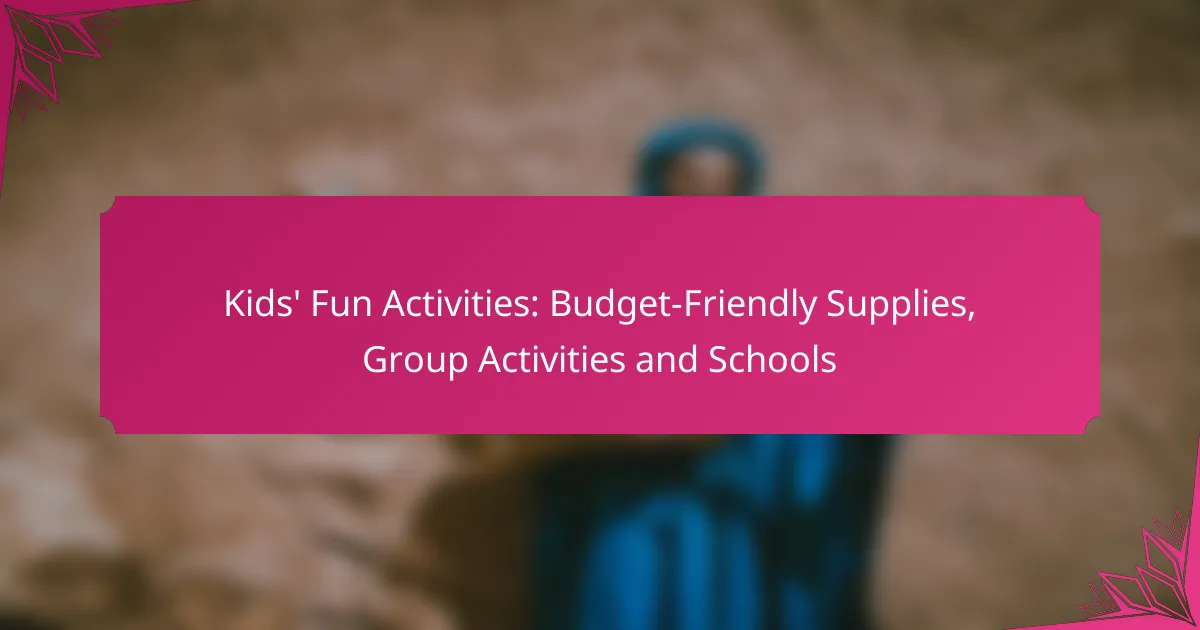Engaging kids in fun activities doesn’t have to be expensive, as budget-friendly supplies can spark creativity and learning. From craft kits to educational games, these affordable materials are perfect for families and schools. Group activities further enhance the experience by promoting teamwork and social skills, while schools can enrich their programs through partnerships and community events.

What are budget-friendly supplies for kids’ activities?
Budget-friendly supplies for kids’ activities include affordable materials that encourage creativity and learning without breaking the bank. These supplies can range from craft kits to educational games, making them accessible for families and schools alike.
Craft kits from Melissa & Doug
Melissa & Doug offers a variety of craft kits that are both engaging and affordable. These kits typically include all necessary materials, making it easy for kids to dive into creative projects without needing additional supplies.
Popular options include wooden craft kits and sticker sets, which can often be found for under $20. These kits not only provide entertainment but also help develop fine motor skills and creativity.
Art supplies from Crayola
Crayola is a well-known brand for art supplies that are budget-friendly and widely available. Their products, such as crayons, markers, and colored pencils, are essential for any child’s art projects.
Many Crayola items come in bulk packs, offering great value for money. Look for seasonal sales or discounts at local retailers to maximize savings on these supplies.
Outdoor toys from Little Tikes
Little Tikes produces a range of outdoor toys that promote physical activity and imaginative play. Options like playhouses, slides, and ride-on toys are designed for durability and safety.
Prices for these toys can vary, but many options are available for under $100, making them a worthwhile investment for outdoor fun. Check for sales at major retailers to find the best deals.
Educational games from Learning Resources
Learning Resources specializes in educational games that make learning fun and interactive. These games cover various subjects, including math, science, and language arts, catering to different age groups.
Many of their products are priced between $10 and $30, providing a cost-effective way to supplement classroom learning at home. Look for multi-player games to encourage group play and social skills development.
DIY supplies from Walmart
Walmart offers a wide range of DIY supplies that are perfect for kids’ activities. From basic craft materials like glue and scissors to more specialized items like fabric and beads, Walmart’s selection is extensive and budget-friendly.
Shopping at Walmart allows parents to find supplies at competitive prices, often under $10 for basic items. Consider buying in bulk for frequently used materials to save even more.

What group activities can kids enjoy?
Kids can participate in a variety of group activities that promote teamwork, creativity, and physical fitness. These activities not only provide fun but also help develop social skills and build friendships.
Team sports like soccer
Team sports, such as soccer, are excellent for kids as they encourage cooperation and physical activity. Children learn to work together towards a common goal, enhancing their communication skills and teamwork.
When organizing soccer games, consider local leagues or school teams. Equipment costs can be minimal; often, a ball and some cones are sufficient to get started. Many communities offer free or low-cost leagues for children.
Group crafts at local community centers
Group crafts at community centers provide a creative outlet for kids while fostering collaboration. These activities often include painting, pottery, or building projects, allowing children to express themselves artistically.
Check with local community centers for scheduled craft days or workshops. Supplies are usually provided, making it budget-friendly. Encourage kids to share their creations, which can boost their confidence and social interaction.
Outdoor scavenger hunts
Outdoor scavenger hunts are engaging and can be easily organized in parks or backyards. Kids work in teams to find items on a list, promoting exploration and teamwork.
To set up a scavenger hunt, create a list of common items found in the area, such as leaves, rocks, or specific flowers. This activity is cost-effective and can be tailored to different age groups, ensuring everyone can participate and have fun.
Science experiments in classrooms
Science experiments in classrooms offer hands-on learning experiences that can be both educational and entertaining. Kids can work in groups to conduct simple experiments, fostering curiosity and collaboration.
Choose experiments that require minimal supplies, such as baking soda and vinegar volcanoes or growing crystals with sugar. These activities can often be done with household items, making them budget-friendly and easy to implement in school settings.

How can schools implement fun activities?
Schools can implement fun activities by partnering with local organizations, planning seasonal events, and collaborating with cultural institutions. These initiatives not only enhance student engagement but also foster community ties and provide enriching experiences.
After-school programs with local organizations
After-school programs can be a great way for schools to provide fun activities without significant costs. By collaborating with local organizations, schools can offer sports, arts, and educational workshops that cater to various interests. These programs often rely on community volunteers and resources, making them budget-friendly.
To implement these programs, schools should identify potential partners in the community, such as youth clubs or art centers, and discuss mutual goals. Regular communication and feedback from students and parents can help refine these offerings to better meet the needs of the community.
Seasonal events like field days
Seasonal events, such as field days, provide an excellent opportunity for schools to engage students in fun, outdoor activities. These events can include games, sports competitions, and creative challenges that promote teamwork and school spirit. Planning these events typically requires minimal funding, especially if schools utilize existing resources and facilities.
When organizing a field day, schools should consider the age range of participants and ensure activities are inclusive. Engaging students in the planning process can also enhance their excitement and ownership of the event, leading to higher participation rates.
Collaborations with local museums
Collaborating with local museums can enrich the educational experience by providing hands-on learning opportunities. Schools can arrange field trips or special workshops that align with their curriculum, allowing students to explore subjects like history, science, and art in an interactive setting. Many museums offer discounted rates or free admission for school groups, making this a cost-effective option.
To maximize the benefits of these collaborations, schools should reach out to museums to discuss available programs and tailor them to fit their educational goals. Scheduling visits during off-peak times can also enhance the experience by ensuring smaller group sizes and more personalized attention from museum staff.

What are the benefits of budget-friendly activities?
Budget-friendly activities provide numerous advantages, including fostering creativity and teamwork among children while ensuring accessibility for all families. These activities allow kids to engage in fun, enriching experiences without putting financial strain on parents.
Encourages creativity
Budget-friendly activities often require children to think outside the box and use available resources creatively. For instance, using recycled materials for art projects can inspire innovative designs and imaginative play.
When children participate in low-cost activities, they learn to express themselves artistically without relying on expensive supplies. This can lead to a greater appreciation for resourcefulness and the value of creativity in everyday life.
Promotes teamwork
Engaging in group activities that are budget-friendly fosters collaboration and communication among children. Activities like team sports, scavenger hunts, or group crafts encourage kids to work together towards a common goal.
Through these experiences, children develop essential social skills, such as sharing, negotiation, and conflict resolution. These skills are vital for their personal growth and future interactions in various environments.
Accessible for all families
Budget-friendly activities ensure that all families, regardless of their financial situation, can participate in enriching experiences. Community centers, local parks, and schools often offer free or low-cost programs that are inclusive and welcoming.
By providing access to affordable activities, communities can help bridge gaps in social and economic disparities, allowing children from different backgrounds to connect and learn from one another. This inclusivity is crucial for building a supportive community environment.

What criteria should parents consider for selecting activities?
When selecting activities for kids, parents should consider age appropriateness, safety standards, and the availability of supplies. These factors ensure that the activities are enjoyable, safe, and feasible within a budget.
Age appropriateness
Age appropriateness is crucial as it ensures that activities match children’s developmental stages. Activities designed for younger children may be too simple for older kids, leading to boredom, while those for older children may be too challenging for younger ones.
To determine age appropriateness, refer to guidelines provided by activity providers or educational resources. For example, arts and crafts kits often indicate suitable age ranges, helping parents make informed choices.
Safety standards
Safety standards are vital to protect children during activities. Parents should look for activities that comply with recognized safety regulations, such as those set by the Consumer Product Safety Commission (CPSC) in the United States.
Check for safety certifications on products and materials. For instance, toys and supplies should be labeled as non-toxic and free from small parts that could pose choking hazards. Always supervise children during activities to ensure they follow safety guidelines.
Availability of supplies
Availability of supplies can significantly impact the feasibility of activities. Parents should assess whether they can easily obtain the necessary materials without exceeding their budget. Local stores or online retailers often provide a range of options at different price points.
Consider using common household items for activities to keep costs low. For example, items like cardboard boxes, old newspapers, and craft supplies can be repurposed for creative projects, making it easier to engage kids without financial strain.
